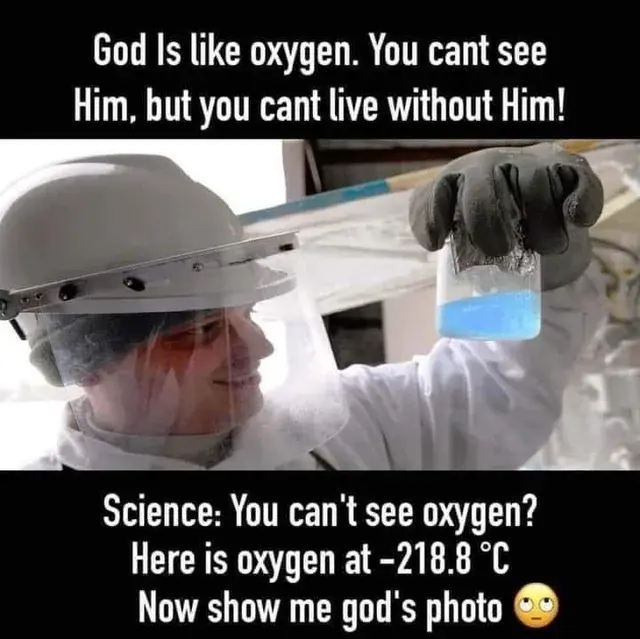this post was submitted on 01 Dec 2023
876 points (94.9% liked)
Atheist Memes
5574 readers
228 users here now
About
A community for the most based memes from atheists, agnostics, antitheists, and skeptics.
Rules
-
No Pro-Religious or Anti-Atheist Content.
-
No Unrelated Content. All posts must be memes related to the topic of atheism and/or religion.
-
No bigotry.
-
Attack ideas not people.
-
Spammers and trolls will be instantly banned no exceptions.
-
No False Reporting
-
NSFW posts must be marked as such.
Resources
International Suicide Hotlines
Non Religious Organizations
Freedom From Religion Foundation
Ex-theist Communities
Other Similar Communities
!religiouscringe@midwest.social
founded 1 year ago
MODERATORS
you are viewing a single comment's thread
view the rest of the comments
view the rest of the comments

I mean, the reason the sky is blue is due to the atmosphere's effects on light and the fact that it's not fully transparent.
Earth's atmosphere is also the reason why we see some stars flickering. The light of the star is constant, but our atmosphere creates diffusion, so some of the photons don't reach our retinas. Technically, if you and your next door neighbor look at the same star, it's flickering for both of you, but the flickering is not synchronous since position of observation matters.
Its blue because of Nitrogen more than Oxygen, considering the relative densities.
And also, ofc, because of Avagadro's Number.
Yeah, should have mentioned that myself as well. Was not my intention to imply that the colour of the sky is the colour of oxygen.
The fact that blue light gets scattered by the atmosphere is due to the fact that there's just so much of it and not bcoz the atmosphere inherently is non-transparent
So the atmosphere interacts with light because it's there, not because it interacts with light??
God works in mysterious ways!
I'm saying if the atmosphere was smaller, scattering would be less and blue colour may not appear. So the blue colour is not because the atmosphere is "not entirely transparent" like the commenter said, but because there is enough of the atmosphere that the scattering effect is prominent.
And yet, if the atmosphere was fully transparent, there would be no scattering of light. The blue colour is an effect of the amount of air, but there would be no colour at all if air was fully transparent.
That is funny. According to you, for a medium to be called "fully transparent" there has to be no scattering of light. By that definition, water and air are not "fully transparent". I'm not sure if such a material exists that doesn't scatter any amount of light.
Correct. The only substance I can imagine being completely transparent would be some kind of dark matter. Everything else still interacts with light, no matter how little. Even deep space isn't completely transparent, as we can tell what elements exists as interstellar and intergalactic dust from spectrographs.
Atmospheric absorption spectrum - We can see (heh) that the atmosphere is completely opaque to most electromagnetic radiation before scattering. Only some microwaves and short radio waves can pass without any absorption.
Atmospheric transmission spectrum - We can see that not even 60% of visible light is transmitted to the surface directly due primarily to scattering losses. That scattered light is why our sky is blue during the day and orange at sunset/sunrise. Mars' atmosphere is orange during the day and blue at sunset/sunrise for the same reason.
The physics of light scattering doesn't change based on how much atmosphere you have, even a single particle can scatter light. In fact, the physics of scattering is based on single particles, and the particle size is what differentiates Rayleigh scattering from Mie scattering. Other interactions with the incident particle can cause Raman and Compton scattering too. None of these need multiple particles.
The density of the atmosphere matters.
Because scattering happens when photons hit particles, so the more particles the more scattering.
Light coming at you thru the atmosphere from above has a much shorter trip through the atmosphere than light coming at you near the horizon.
The longer path length means more chances to hit particles and scatter and the higher frequency 'blue-er' light gets filtered out more or absorbed and reradiated as a lower frequency light, more so than the lower freq red/yellow light.
Photons should be fully transparent right?
Yes, more stuff means more scattering, but scattering happens at all scales.
Photons don't cause absorption or scattering with themselves, no, but they do interfere. The interference really only shows up when the waves are nearly in-phase, so random light rarely interferes, but it should happen.
Photons aren't matter anyway, so I can't make a substance out of them. The rest of the bosons should interact with light even less, although the gravity of their energy might bend it the tiniest amount.
That seems to be the scientific consensus, yes. It's like friction, no material is truly frictionless just like no material is truly completely transparent. The ocean gets real dark once you get deep enough which does seem to suggest that water is not fully transparent.
I remember my 8th grade textbook's chapter on light, and on the first page it says that transparency is a quantitative measure, not a binary yes or no.
I love when people are both nitpicky AND wrong